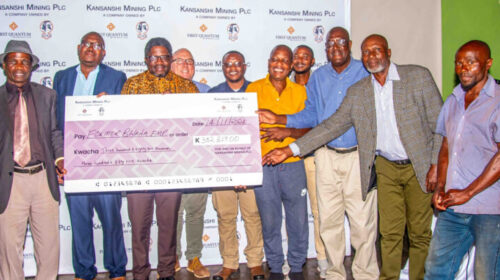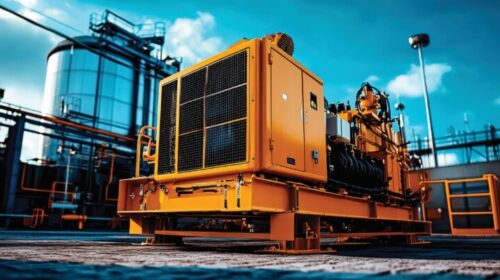Zambia Chamber of Mines President lays out mining’s biggest challenges
Hot on the heels of the latest Zambia Extractive Industries Transparency Initiative (ZEITI) report, which illustrates how significant the mining sector’s contribution is, President of the Zambia Chamber of Mines Dr Godwin Beene sets out what’s necessary for a mining breakthrough – and the realisation of the New Dawn Government’s stated goal of tripling copper production.
ZEITI’s latest annual report details exactly how much Zambia’s Government received from the mining industry between 1 January 2020 and 31 December 2020, and provides a company-by-company breakdown of financial contributions to the economy. In 2020, that amount was ZMW 25 billion (including tax and non-tax payments) which was received by Government agencies and the Ministry of Finance. Yet the perception that Government does not receive its ‘fair share’ of money from the mines is ever more widespread. Where does that come from?
We must distinguish between the amount of taxes received by the State, and the impact derived from how those taxes are spent. We can see that the contribution is very large – and this does not even factor in the economic impact of procurement spending, or employment as it filters through our broader economy. But, without increased transparency into exactly where (departments, projects, provinces, districts, etc) these revenues are allocated, and how they are spent, the public is likely to continue asking this question. One way to improve transparency as it relates to the mining sector might be to request more information from government agencies about this revenue allocation.
You mentioned that the ZMW 25 billion financial contribution does not factor in the economic impact of procurement spending or employment on the broader economy. How many Zambians do the mines employ, and how does that compare to the number of expatriates employed?
Data in ZEITI’s report shows that fourteen mining companies employed or contracted 45,813 people, of which 1432 (3.12%) were expatriates. This is a low percentage, compared to other mining jurisdictions without the history of mining, and the mining skills, that Zambia has.
Who verifies the data in ZEITI’s report?
All the revenue that mining companies declare they have paid is reconciled with revenues that Government declares it has received. ZEITI is the local chapter of the Extractive Industries Transparency Initiative (EITI) – a global coalition made up of members of Government, Civil Society Organisations, and mining companies. ZEITI’s report (and the reconciliation process itself) is a collaborative process which is overseen by a Multi-Stakeholder Group, the Zambia EITI Council (ZEC). It consists of 18 members from three sectors – Government, industry, and civil society – so its very structure ensures complete transparency by all parties.

Taking a step back from the data, how is our mining industry faring on the whole?
The industry performed well in 2020 – the year that this latest ZEITI report covers – which is no small achievement, given the restrictions that the COVID pandemic introduced. But that’s one year; the story of the last decade has unfortunately been one of lost opportunities.
The 837 000 tonnes of copper that the ZEITI reports were produced in 2020 was an increase on production in 2019, but less than the tonnage produced in 2018. In short, the industry has stalled, and is in relative decline when you compare our situation to the tremendous growth in mining that the DRC has experienced over the last decade or so.
“The industry performed well in 2020 – but that’s one year; the story of the last decade has unfortunately been one of lost opportunities.”
Zambia is still far from reaching its full potential, which is primarily the result of an uncompetitive and ever-changing mining tax regime. Repeated shocks and disappointments have seen investment dry up, and attracting investment is key to ensuring copper production rises, through launching new mines or sustaining existing ones.
As this Government recognises, increasing mining production, of copper especially, would allow Zambia to take advantage of the increased demand driven by the “green technology” revolution, and to reap the economic benefits that will come with meeting growing global copper demand – particularly while the price is high.
Unfortunately, the last decade has been wasted, and we are not currently well placed – given the decade-long lead time to bring mines into production – to meet these opportunities. But all is not lost, if we act with speed. Other jurisdictions, particularly those in South America that have seen the greatest growth in recent years, may become less attractive investment destinations, as their national politics shifts to the left. So, there is potentially a window of opportunity opening for Zambia.
The announcement in the 2022 Budget speech that mineral royalties will once again be regarded as costs to the business, and therefore deductible against income tax – as they are everywhere else in the world – is a crucial first step in giving investors the ‘green light’ that they’ve been waiting for.
Is that one measure enough? I don’t think so. We have been telling the Government for years now what is needed. The IMF released a key comparative mining policy study last year, that objectively showed our effective tax rate to be, by a large margin, more than all other mining jurisdictions. Given that we have no comparative advantages to offset this, we simply are not competitive – hence why no major mining investments have been made in the last decade.
To attract the investment necessary to achieve the massive increase in production the Government has committed itself to, we will need to see the tax regime come back into line with other mining countries. This will mean reviewing the structure of royalties – in particular, the step change between rate bands, as well as reviewing the rates themselves. Should this happen, we hope to see investments into Lubambe Copper Mine, and Kansanshi. Importantly, we would also likely see significant renewed interest in exploration, which is crucial to us developing our pipeline of new mines.
You refer to “renewed interest in exploration.” How much exploration activity are we currently seeing?
Far, far less than we were ten years ago. The Chamber firmly believes there is room for expansion in exploring cobalt, nickel, gold, emeralds, manganese — as well as copper — which would diversify our minerals basket. However, this would require significant exploration to identify minerals deposits. But exploration is a high-risk activity – the chances of finding nothing are high – and therefore exploration will only occur if there is the prospect for the investors risking their capital, of making a good return on the small percentage of deposits they find that can be effectively mined.
What are some of the other challenges that mining companies face?
There is a range of long-standing challenges, all of which are well known to this Government – as they were to the preceding Government. The main challenge, as I have already said, is our uncompetitive mining tax regime, which was prone to constant tinkering and change by the previous Government.
“The main challenge is our uncompetitive mining tax regime, which was prone to constant tinkering and change by the previous Government.”
Unfortunately, the constant short-term shakedown of the industry to plug some of the gaping holes in the fiscus and to keep the party going, really destroyed trust and has made investors extremely wary of Zambia.
People need to understand that modern mining is a high-risk, complex undertaking; there can easily be a 15-year time gap between finding a deposit – which as I’ve said is hard enough to find – and bringing a mine into production, and then receiving your first income. For years, the whole process requires billions of dollars of investment for a large operation, before there is any return at all. Of course, these risks are surmountable and potentially attractive, IF the return is there. Right now, it is not.
So, we need to offer an adequate return if we are to encourage investment. That is just common business sense. And we need to commit to this long-term, and not keep changing our minds. Stability is particularly important for mining, given the long timeframe we are talking about. Investors need to know that the rules of the game won’t change overnight, which throws out their calculations entirely. You have to give people the confidence that if they are investing in our country for the long term, over many decades, that we won’t turn on them once they’re committed. If we do, you can be sure that all other potential investors will sit up and take note, and either go somewhere more inviting, or demand a higher premium for a country they now judge as having high political risk.
Hot on the heels of the perception that Government does not receive its ‘fair share’ from the mining sector is the suspicion that mines do not declare all the copper that they produce and sell, and therefore only pay tax on a select portion of copper. How do we know that the amount of tax paid to Government (as reported in ZEITI’s report) accurately reflects the tax that is rightfully owed?
Exports of copper are closely reported to and monitored by ZRA customs, as any copper leaving Zambia will need to be declared to ZRA. I understand there are also a number of testing facilities and laboratories which check that the copper which is being exported is tested to ensure that it is at the quality level which it is being declared at i.e. protecting from high quality copper being declared at a lower quality level.
Production levels as well as the taxes payable are also subject to detailed review by independent statutory auditors as well as by the ZRA themselves, meaning there are numerous checks on the accuracy of levels of production and the related tax payments.
There’s talk of mineral royalties being scrapped altogether in future. Is this possible? If not, what changes is the Government making to the mining tax regime, and who will these changes benefit most?
There is a common misconception that MRT is being scrapped or altered in some way due to the changes announced to the mining tax regime in Budget 2022. I can however confirm there are no changes being made to the MRT regime itself, and in 2022 mines will continue to pay MRT on the same basis as in 2021.
The change announced which related to MRT is the corporation tax treatment of this expense. The change simply reinstates the historic treatment (pre 2019) where a mining company can treat the mineral tax expense incurred as a deductible expense in the calculation of corporation taxes, removing the element of double taxation introduced in 2019. This change brings Zambia in line with international norms.
***
ZEITI’s recent announcement has demonstrated that the level of data collection and reporting in Zambia is already well in line with international standards. Once the country’s mining final regime, too, comes in line with international norms, it will set in motion the economic recovery that we’ve all been waiting for, and allow Zambia to realise the full range of economic opportunities which the mining sector can offer.
Find out more about the frameworks that are already in place to ensure transparency and accountability within Zambia’s mining sector, by looking out for our upcoming ‘Transparency & Accountability’ series on our website or social media platforms. Alternatively, send your address to info@miningforzambia.com to receive an email the minute the first instalment is published, or use the ‘transparency & accountability’ tag (below) to locate the series any time.
![]()





